Barcelona's Panot: Paving the Way to a Better City
- jessicaseldner5592
- May 28, 2022
- 4 min read
As you walk around Barcelona, there are many amazing things to look at. Whether it be the glorious architecture, the fruits and flowers on display in local markets, or even flocks of pigeons and green parrots, there is always something grabbing your attention. In such a beautiful bustling city, it’s easy to get wrapped up in your surroundings.
But what if I told you that one of the most fascinating and unique parts of Barcelona lies beneath your feet! I don’t mean some ancient underground tunnel or tomb. I’m talking about the very ground you walk on. The tiles are called panots, and there is a lot to learn about them.

Just like the rest of the city, the tiles of the sidewalk were very intentionally planned, and they carry a lot of history. Each region of the city has a different type of tile. There are at least 10 different tiles throughout the streets of Barcelona.
Each one was created by Spanish architects such as Antoni Gaudí and Josep Puig i Cadafalch. All the architects that have contributed did so by working with the company that’s been designing pavement for the city for over a century -- Casa Escofet
Let’s go back to what life was like before these stylish pavers to see how far the city has come and why.
History
Before the 20th century, residents in Barcelona were required to pave the 2.5 square meters in front of their building. It was their duty to find bricks or purchase stone from Montjuic or source the paving materials from a specific company.
This was very difficult for people to manage, and it was problematic when the sidewalks would be demolished and out of order whenever new residents wanted to change them. People ended up using a variety of mediums, from asphalt to concrete to mud. This disorganized and unregulated process gave Barcelona the nickname "Can Fanga," or Mud House. It even led to the use of the derogatory term "fanguers" for people who lived in Barcelona.
With the appearance and reputation of the city going downhill, Barcelona’s city council set out to standardize the paving process to resolve this issue in the early 1900s. In 1906, they held an auction to find a company that would pave the entire city. Casa Escofet, a company with designs from several famous architects, won the bid. City officials ordered 10,000 square meters of tiles, each 20 cm X 20 cm X 4 cm.
The Tiles Today
The "Flor de Barcelona" has become an icon of the city. It is a symbol featured on government buildings, merchandise and even human bodies.
The tattoo shown above was featured on the Logia Barcelona tattoo shop website.
Blanca Martinez-Castel is the manager of Compliments Sales, the store for travel items where the tote bags in the middle picture are from. She explains what this symbol means to her.
"I love the flower design. It's classic and unique to our city."
She says she takes pride in selling products with the Flor de Barcelona design.
"Did you know it's my best-selling bag?"
This panot was created in 1926 and is known for being the main one in the L'Eixample district. It was designed by Puig I Cadafalch.

This red Flor de Barcelona panot is extra special. These circular tiles are placed along the "Ruta del Modernisme," or Modernism Route.
They are placed in front of buildings with historical significance. These are modernist buildings or symbols representing the astounding architecture of Barcelona.
The second most famous type of panot is the Pedrera tile designed by Gaudí. This style is hexagonal and characterized by complex designs that seem to show leaves and swirls. This tile is found in the Passeig de Grácia.

The Pedrera tile is considered to be the first product made of an industrial design. It is featured in the Museum of Modern Art in New York City.
The design is supposed to depict life on the ocean floor. There are starfish, ammonites and algae. It takes seven tiles to show the full pattern and reveal all three of the subjects in their entirety.
The shape and design of the Pedrera tiles made them especially prone to wear and damage. Between 2009 and 2011, Barcelona spent about €150,000 or $160,982 replacing tiles that had been stolen or broken.

Then in 2014, art students from the University of Barcelona created a campaign on social media called #SOSPanotGaudí, demanding that the city should fix all the sites where the seven-tile pattern got interrupted. In a few months, the replacement of the incorrectly laid tiles began.
Pol Noya Híjar was one of the people who contributed to the campaign by posting a picture of incorrectly laid tiles. He explained why it was important to him.
"Gaudí worked so hard to create this beautiful design. It's up to the city to do it justice."
Other Panot Designs
In order from top to bottom and left to right, the featured tiles are referred to as: Concentric Circles, Mataró, the Star, the Rose, Diagonal, and Street Name Tiles.
See For Yourself
If you are interested in finding these panots, all you have to do is walk around in the city. There are some must-see locations to visit first:
Passeig de Gràcia between Gran Via and Diputació: In this area, you can find some of the last remaining Gaudí originals on the right side of the street as you walk uptown.
From Passeig de Gràcia towards Plaça d’Espanya on Diputació: This spot features all of the tiles. If you are on the side of the street closest to Gran Via, you can even find the oldest ones.
Ronda Universitat 20: This was the original address of the Casa Escofet company. In its place, there is currently a Woki Organic Market. If you go there, you can still see the facade of the building which was constructed in the Modernista Era.
Passeig de Gràcia 41: The original rose tiles still lay at the entrance of the Casa Amatller.
Jaume I Metro Stop: At the Leitana crosswalk between Placa de l' Àngel and Carrer de la Bòria, the street name tiles are located on the Gótic side.
If you are really attached to the beauty and history of the panots, you can buy one that was "rescued" from the street and restored. Or you can just take pictures. Either way, you will be able to preserve the timeless symbol that salvaged the sidewalks and image of Barcelona.















Comments